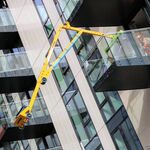I'm honestly a bit tired of hearing the concept of induced demand as the means to cancel any road infrastructure project, it really isn't that simple. At a high level, yes, induced demand acts to attract additional traffic to a new, more attractive, route option when it is introduced. The fact is that this attraction also removes vehicles from an adjacent or parallel route between the origin and destination. Sure, there will be new drivers, who previously had no means of taking the highway and perhaps bought a car to begin using the new highway route, but that portion of individuals is incredibly small compared to those actually using it. The reality is that people aren't THAT mode choice flexible. If someone was using transit before, a new highway is very unlikely to give them the means to purchase a vehicle and change their travel mode. Don't get me wrong, in all these forecasting analysis, there is certainly a consideration given to mode shift, but the fact is that mode shift does not automatically fill capacity. In fact, the projects are designed to accommodate existing capacity in addition to those vehicles which are attracted from other routes, thereby relieving these other routes for other origin-destination pairs.
Now, if you're suggesting that, in the 10 to 20 years that follow the introduction of the new highway, we will see the additional capacity slowly fill up with new commuters, then that has nothing to do with induced demand. That's demand growth due to new population and new employment, and those trips will accumulate with or without the introduction of the new highway. Personally, I'd rather we have excess capacity to fill rather than be above capacity wondering where to put the demand. That simply isn't a reason to cancel the project altogether. Within 20 years of Ontario Line being built, we will be near capacity. Perhaps there's no point building that either due to the induced demand.
I love transit. I want more transit. I want the Ontario Line, I want Eglinton Crosstown to open already so we can build the east and west extensions, and I want mixed use corridors throughout our City to provide additional capacity for all modes of travelers. But I also understand the reality faced by individuals at the north end of Peel Region and York Region. I understand that Highway 401 between 410 and 400 is one of the biggest bottlenecks in the City that needs parallel corridors for additional capacity. That's why I'm in favour of this project.
Look at it for the long run. As this highway is built, more housing is built in Northern Brampton, Bolton, Georgetown, etc, this highway is filled with new commuters. The thing is, no one uses their cars because they absolutely love their cars and have to. Or at least, very few people. If we build more transit lines, along major corridors, with 5 minute bus service during all hours (except late night) then we can get more people using transit. All it requires is vision and willingness to build with the plan, rather than just doing endless studies.
People choose their mode based on how fast it is, how much it costs, how convenient it is, and so on. The secret to making transit successful is to make it all of those things. For those saying "we need sprawl," no we don't. I'm not suggesting everyone live in "commie blocks" where each family has 2 bedrooms. To be fair, that is the perception that we have of high-rise in North America. This is because developers go for profit, which means maximizing units, which means small units. We don't have to do that. In both Europe and Asia, many high-rises have multi-storey units, many of them larger than the house I am writing this from. We can densify, while not forcing people to live in cramped apartments, for many years to come and without sprawl.
Many proponents will talk about growing the industrial areas and the need to serve them. We can build something like this:
Instead of building a full freeway, which will inevitably get upgraded again and again, we can build an arterial road with fewer lights. If the lesser sprawl option was chosen, it would only have to serve current residential and industrial, but it would leave much less of a scar on the landscape. In the event of a sprawl boom in the area, perhaps land can be reserved for a freeway.

Ew.
Finally, another government can come along, sell this highway, and we have another 407 where we can't use the highway to alleviate congestion. The 407 is 7.5 kilometers from the 401 at the 400, and the 407 is only 4 kilometers from the 401 at the 410. I wonder if it would not be cheaper to negotiate with the 407 consortium, to limit toll price raises, and perhaps allow some congestion. While this
would diminish the idea that the 407 is an express route, perhaps there can be some sort of compensation. How much would this cost?
To conclude, this freeway has some advantages (industrial access) but the disadvantages outweigh it. The cost, the damage, and the sprawl incentive make me conclude this freeway should not be built. Instead, we need reduced tolls on the 407, a 4-lane limited access, though not full freeway, road through the area, more transit, and less sprawl. All it takes is vision and determination to get around the power of the 905.




